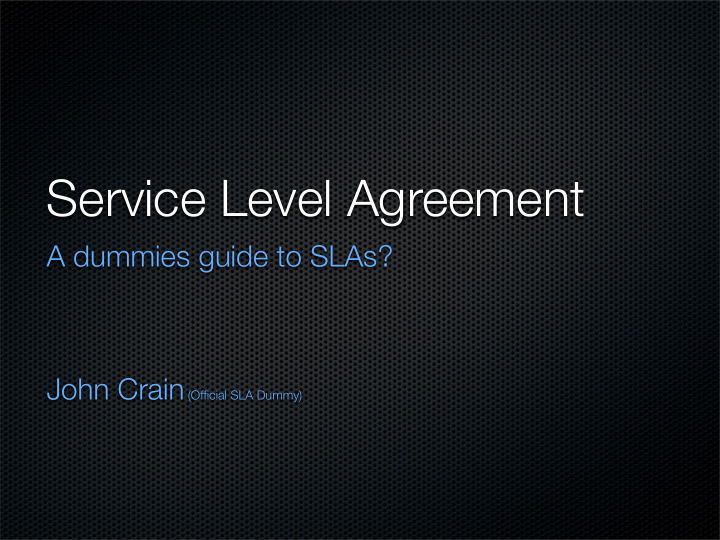



Service Level Agreement A dummies guide to SLAs? John Crain (Official SLA Dummy)
Service Level Agreements Referred to as SLAs An SLA is a formally negotiated agreement between two parties. It is a contract that exists between customers and their service provider, client or between service providers. It records the common understanding about services, priorities, responsibilities, guarantee, and such — collectively, the level of service . For example, it may specify the levels of availability, serviceability, performance, operation, or other attributes of the service like billing and even penalties in the case of violation of the SLA.
What does an SLA do?
Sets definitions “Monthly Timeframe shall mean each single calendar month beginning and ending at 0000 Greenwich Mean Time (GMT)”. Defines the levels of service. “..will update the WHOIS Service once per day beginning at 1200 GMT“
Defines how measurements are made From where? How often? Using what tools? Includes the penalties for failure Payment? Credits? Includes dispute resolution policies How will disputes about the SLA be solved?
We all deal with SLAs in real life! Go look at your contracts for your telephone line or at your plane ticket. We often have no input into what those service levels are!
Services where you may already have SLAs as the client? Maintenance and Support Most hardware and software manufactures will sell you a support contract. How long until an engineer will turn up? Are software upgrades included? Bandwidth Guaranteed uptime? Guaranteed throughput?
Are you a service provider?
What are the services you provide? Here are a few but the exercise is to think about others.
DNS resolution From any point in the Internet your ccTLD should probably resolve, 100% of the time 24/7/365 If you outsource how are you controlling this? What are the penalties if you don’t?
Registration What percentage of time can registration be unavailable. Who is the client? End-User or Registrar? How quickly does a zone update occur?
Dispute resolution At a minimum you provide the service of documenting, updating and publishing the process. If you provide the DR process (or parts of it) then there is probably a complex SLA just for this service!
SLAs as a management tool Don’t underestimate the power of documented SLAs. “We guarantee our customers service!” “We have defined SLA’s and here is the public report of how we meet them”
You can build systems to meet SLA’s If you know you need 24/7/365 DNS resolution then think about what can cause that to fail. If your SLA says push zone at 12:00 GMT, how do you guarantee that?
You can use systems (and reality) to build your SLAs Can you realistically provide 100% access (24/7/365) to your registry interface? What is acceptable to you and customer? 75%? 99.4%? 99.9% (43.2 min/mon)?
Exceeding SLA’s? Is it always a good thing? Is it more expensive to consistently deliver a 4hr response than a 24hr response? Dedicated staff vs part time vs best effort... All different costs..
Don’t write these on your own Service Level Agreements are legal documents (Lawyers) that define both business (Accountants) and technical (Engineers) aspects of services. The best ones look after the interests of both parties.
There is an entire industry dealing with services and service levels! Systems for defining services (For IT look at ITIL) Consultancies Software for managing, monitoring reporting SLAs. (Including open source solutions)
Recommend
More recommend